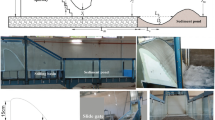Abstract
Local scour downstream of hydraulic structures is one of the critical phenomena, which has absorbed a vast amount of interests by researchers. The designers of hydraulic structures, particularly, spillways try to utilize proper means to minimize the consequences of excess energies downstream of such structures which usually tend to erode their immediate downstream reaches. The stepped spillway is designed to create a large amount of energy losses by action of its steps to lessen the amount of scour evolution at its immediate downstream. This article presents the results of 67 experiments conducted at two different scales of stepped spillways, to study the local scour downstream of the structure. The experiments were planned to consider a wide range of geometrical factors, flow characteristics, and sediment properties. The time duration of experiments was ranged from 6 to 24 h which produced more than 80000 data points for analytical considerations. The results were used to render some regression equations to define the similarity among the scour hole profile and its geometrical characteristics. It was observed that a long-term observation would be required to reach the equilibrium state. However, semi-equilibrium conditions will be achieved some times after 24 h. It was also noted that the depth of scour hole adjacent to channel walls was bigger than that of centerline. Finally, it was realized that the stepped spillway causes energy dissipation between 42.06 and 74.82% which results in a shallower scour hole compared to ogee spillways.













Similar content being viewed by others
Abbreviations
- B (cm):
-
Width of the flume
- x s (cm):
-
Maximum length of scour hole
- C u :
-
Uniformity coefficient of sediments
- q (\(\frac{{{\text{l/s}}}}{{\text{m}}}\)):
-
Discharge intensity
- D 50 (cm):
-
Sediment size
- h s (cm):
-
Height of steps of spillway
- FrD :
-
Particle Froude number
- g (m/s2):
-
Acceleration due to gravity
- FS:
-
Shape factor of sediments
- t :
-
Time
- H d (cm):
-
Height of stepped spillway
- y tw (cm):
-
Depth of tail-water
- H max (cm):
-
Total energy height upstream of spillway
- l s (cm):
-
Width of steps of spillway
- L B (cm):
-
Length of stilling basin
- σ g (cm):
-
Geometric standard deviation of sediments
- Q (l/s):
-
Flow discharge
- ρ s (kg/m3):
-
Mass density of water
- \(V\left( {\frac{{{\text{c}}{{\text{m}}^{\text{2}}}}}{{\text{m}}}} \right)\) :
-
Volume of transmitted sediments from hole
- ρ s (kg/m3):
-
Mass density of sediments
- y m (cm):
-
Maximum depth of scour hole
- ϕ :
-
Angle of repose
- x m (cm):
-
Position of maximum depth from stilling basin
- \(\mu \left( {\frac{{{\text{N}} - {\text{s}}}}{{{{\text{m}}^{\text{2}}}}}} \right)\) :
-
Dynamic viscosity of water
- x me (cm):
-
Position of maximum depth from stilling basin under equilibrium condition
- x se (cm):
-
Maximum length of scour hole under equilibrium condition
- y me (cm):
-
Maximum scour depth under equilibrium condition
- \(V_{{\text{e}}} \left( {\frac{{{\text{cm}}^{{\text{2}}} }}{{\text{m}}}} \right)\) :
-
Volume of transmitted Sediments from hole under equilibrium condition
References
Alemi M, Maia R (2016) Numerical simulation of the flow and local scour process around single and complex bridge piers. Int J Civ Eng 1–13. doi:10.1007/s40999-016-0137-8
Kazemi F, Khodashenas SR, Sarkardeh H (2016) Experimental study of pressure fluctuation in stilling basins. Int J Civ Eng 14(1):13–21
Li S et al (2016) “Simulation and experiments of aerated flow in curve-connective tunnel with high head and large discharge. Int J Civ Eng 14(1):23–33
Safarzadeh A, Noroozi B (2016) 3D Hydrodynamics of trapezoidal piano key spillways. Int J Civ Eng 15(1):89–101
Kavianpour MR, Masoumi HR (2008) New approach for estimating of energy dissipation over stepped spillways. Int J Civ Eng 6(3):230–237
Larsen EM (1952) Observation on the nature of scour. In: Proc. 5th Hydraulic Conference. University of Iowa, Iowa City, USA, pp 179–197
Farhoudi J (1979) Scaling relationships for local scour downstream of stilling basins, PhD diss, Southampton University
Farhoudi J, Smith KV (1985) Local scour profiles downstream of hydraulic jump. J Hydraul Res 23(4):343–358
Dey S, Westrich B (2003) Hydraulics of submerged jet subject to change in cohesive bed geometry. J Hydraul Eng 129(1):44–53
Dey S, Sarkar A (2006) Scour downstream of an apron due to submerged horizontal jets. J Hydraul Eng 132(3):246–257
Shayan HK, Farhoudi J (2015) Local scour profiles downstream of adverse stilling basins, Scientia Iranica. Trans A Civ Eng 22(1):1–14
Dargahi B (2003) Scour development downstream of a spillway. J Hydraul Eng 41(4):417–426
Shayan HK, Farhoudi J, Hamidifar H (2015) Estimation of maximum scour depth downstream of horizontal and adverse stilling basins using a semi-theoretical approach, Int J Civ Eng 13(1A):1–15
Tuna M, Emiroglu M (2011) Scour profiles at downstream of cascades. Sci Iran 18(3):338–347
Emiroglu ME, Tuna MC (2011) The effect of tailwater depth on the local scour downstream of stepped-chutes. KSCE J Civ Eng 15(5):907–915
Tuna M (2012) Effect of offtake channel base angle of stepped spillway on scour hole. Iran J Sci Technol Trans Civ Eng 36(C2):239–251
Raudkivi AJ (1998) Loose boundary hydraulics. CRC Press, Boca Rotan
Chanson H (2001) The hydraulics of stepped chutes and spillways, Balkema, Lisse, ISBN 90 5809 352 p 2
Author information
Authors and Affiliations
Corresponding author
Rights and permissions
About this article
Cite this article
Aminpour, Y., Farhoudi, J. Similarity of Local Scour Profiles Downstream of Stepped Spillways. Int J Civ Eng 15, 763–774 (2017). https://doi.org/10.1007/s40999-017-0168-9
Received:
Revised:
Accepted:
Published:
Issue Date:
DOI: https://doi.org/10.1007/s40999-017-0168-9



